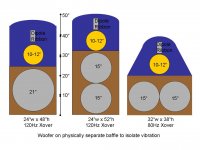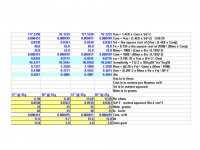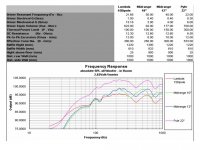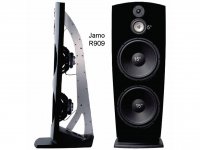swak said:Nick,
I followed the discussions of current source amps some years ago on this forum and have read Hawksforth's papers on the topic. The advantages are considerable less compression and distortion. I am by far not an expert on driver design, but perhaps you can have important pointers on the following thread: http://www.diyaudio.com/forums/showthread.php?threadid=3889 , look for Thorsten's (a.k.a. Kuei Yang Wang) posts.
Ok, I was finally able to read some of this. It sounds like our designs already approach the distortion ideal especially the upcoming field coil. What he is describing is the effect of current/voltage on speaker distortion and how bad ceramic magnets really are the more you pump power into the motor. Well much of the eddy current problems are cured with the faraday ring we use (the thick copper sleeve over the coil)
The only major change I see would be to short the voice coil former completely to have a Qm approaching zero. The best way to do this is to make a very thin wire second coil that is wound the full length of the regular coil and short it via a second terminal with a variable resistor so you can get just the amount of damping you want. Anyone can test this principle with a DVC speaker to see if it can work for them. Then if it does having a special coil made so the second coil is very small and the motor stays strong would be easy.
BTW - Our field coil and Alnico designs will still use the copper sleeve faraday ring as it is needed for low inductance and heatsinking as well.
Three possible 3-way open baffle sizes for modeling.
The bass baffle should be physically separated from the mid-tweet to remove vibrations. Assuming the midrange is clean up to 1,500 Hz, the tweeter can be a dipole ribbon, or monopole waveguide/horn and compresson driver, or high efficiency dome tweeter with or without small horn/waveguide.
A wider baffle, like 32", seems desirable for 80Hz bass-mid Xover since 80Hz is close to the baffle dipole frequency, and this might simplify the Xover circuit.
The bass baffle should be physically separated from the mid-tweet to remove vibrations. Assuming the midrange is clean up to 1,500 Hz, the tweeter can be a dipole ribbon, or monopole waveguide/horn and compresson driver, or high efficiency dome tweeter with or without small horn/waveguide.
A wider baffle, like 32", seems desirable for 80Hz bass-mid Xover since 80Hz is close to the baffle dipole frequency, and this might simplify the Xover circuit.
Attachments
Some guesses for T/S parameters for a 10" and 12" midrange assuming 0.85" thick Ceramic_5 magnet on the Lambda underhung motor. It looks attractive to search for a "magical" 12" curvelinear cone profile which has unusually good 30 and 45 degree off-axis response. A 10" seems the more successful option for a 1,500 Hz Xover target with low beaming.
30 AWG Copper clad aluminum wire seems capable of ~ 6 gram voice coil which is necessary for the low Mms used in this guess.
30 AWG Copper clad aluminum wire seems capable of ~ 6 gram voice coil which is necessary for the low Mms used in this guess.
Attachments
The Jamo R909 is artistic, but seems midrange challenged with just one 89 db/watt 5" Seas magnesium cone speaker. Stacking two 15" dipole woofers looks very attractive, but loses floor gain of wider baffle with both 15" woofers on bottom. Magnetar has blessed monster big 21" woofers IF the midrange can cover down to 120Hz or below....his EV SRO-12 Ultimate Midrange allows attractive packaging with few audio compromises.
Lynn Olsen (with help from his wife) and Magnetar have moved from a Romy the Cat lone wolf erector set horn setup to more living room family acceptable dipoles. Ultimate Midrange is the key.
Lynn Olsen (with help from his wife) and Magnetar have moved from a Romy the Cat lone wolf erector set horn setup to more living room family acceptable dipoles. Ultimate Midrange is the key.
Attachments
The current thoughts are:
New cone and very small roll foam surround, this is the major design change as this is where all the sound quality issues are for a 2Khz crossover target with such a large driver (the motor will take us to 4Khz easily). This is a new shift from my prior designs as they were all bass first and midrange second. This one will be midrange first and low bass second.
2 motor versions come to mind:
Small flatwire overhung coil TD type motor, basically an M model with the new cone. This would have the highest sensitivity. Also for those that care this will also have the lowest Qms.
Small roundwire underhung coil with the motor from the Dipole. Would be lower sensitivity like for a sealed or small ported cabinet. This would have higher Qms as compared to above.
The future Alnico and Field Coil motors would all be high sensitivity of course, well the Field Coil you can do what you want actually.
All of the parts for this are already on the shelf except for the cone. Its spending some time with various cone and surround samples that will be the long term part of the testing.
New cone and very small roll foam surround, this is the major design change as this is where all the sound quality issues are for a 2Khz crossover target with such a large driver (the motor will take us to 4Khz easily). This is a new shift from my prior designs as they were all bass first and midrange second. This one will be midrange first and low bass second.
2 motor versions come to mind:
Small flatwire overhung coil TD type motor, basically an M model with the new cone. This would have the highest sensitivity. Also for those that care this will also have the lowest Qms.
Small roundwire underhung coil with the motor from the Dipole. Would be lower sensitivity like for a sealed or small ported cabinet. This would have higher Qms as compared to above.
The future Alnico and Field Coil motors would all be high sensitivity of course, well the Field Coil you can do what you want actually.
All of the parts for this are already on the shelf except for the cone. Its spending some time with various cone and surround samples that will be the long term part of the testing.
tinitus said:Now you are at it could you design a 90db(+?) 15"woofer with Fs 18hz and Qts 0.40 ... fore a 180liter closed box, and to cover 25-300hz ... relative "low" mass(100gr?) and soft surround
We have a SB15 that is designed for a closed cabinet. The Mms can never be that low for this design though.
pdan said:OT.
How about a cone tweeter? Not many of these things around; a good one would fill a gap in the market.
Cilla
I doubt we could ever get it cheap enough for this market and the tooling costs would be very high since everything for it would be unique. Now a semi-horn dome with an Alnico motor, that might be possible.
nickmckinney said:
We have a SB15 that is designed for a closed cabinet. The Mms can never be that low for this design though.
Pardon me, but I honestly dont understand
Dipole15 does 90db and 21.7 Fs with only 90gr mms, so why does SB15 need more than double mms to do the same
tinitus said:
Pardon me, but I honestly dont understand
Dipole15 does 90db and 21.7 Fs with only 90gr mms, so why does SB15 need more than double mms to do the same
You are looking only at free air specs. Once you load the driver in a cabinet the air in the cabinet becomes the new compliance in series with the driver's own compliance. If this cabinet volume is less than the Vas of the driver (which it usually is) the Fs of the driver is moved higher in frequency (and called Fb). The smaller the cabinet the "stiffer" this new compliance spec for the driver becomes and the higher in frequency Fb shifts to.
So for a 3-6 cubic foot sealed box cabinet you usually need extra Mms to have a decent low bass extension. We add mass rings to these drivers as well as using a heavy cone. That 21.7Hz free air resonance of the Dipole15 would probably come in around 60+Hz in a small sealed cabinet like the SB15 would enjoy.
Ok, here is some info on a 15" midrange I just put together with standard parts we use. Efficiency can go up at the cost of Q dropping, but here is what I came up with for off the shelf parts.
Fs: 33Hz
Qts: .514
Qes: .53
Qms: 21.7
Re: 10.8 with coils in series
Le: .5mH
Vas: 280L
Mms: 74g
Cms: .315
Bl: 17.7Tm
1W SPL: 94.6dB
Now the interesting thing is that this is a dual 8ohm nominal coil. With coils in parallel we have about 2.7ohm DCR and 99.5dB 2.83V sensitivity. Inductance is a tiny .125mH with coils in parallel. We can probably get an extra 1-2dB out of it if the gap is tightened up more.
Oh, also I forgot to mention this is an underhung midrange. Ruler flat Bl curve out to 3.5mm and then Xmax of about 5mm based on the Bl curve and .707 x rest value.
John
Fs: 33Hz
Qts: .514
Qes: .53
Qms: 21.7
Re: 10.8 with coils in series
Le: .5mH
Vas: 280L
Mms: 74g
Cms: .315
Bl: 17.7Tm
1W SPL: 94.6dB
Now the interesting thing is that this is a dual 8ohm nominal coil. With coils in parallel we have about 2.7ohm DCR and 99.5dB 2.83V sensitivity. Inductance is a tiny .125mH with coils in parallel. We can probably get an extra 1-2dB out of it if the gap is tightened up more.
Oh, also I forgot to mention this is an underhung midrange. Ruler flat Bl curve out to 3.5mm and then Xmax of about 5mm based on the Bl curve and .707 x rest value.
John
John_E_Janowitz said:Ok, here is some info on a 15" midrange I just put together with standard parts we use. John
Hi John,
Maybe it's time you hire a high school Wiz Kid to make some measurements.
The Lambda underhung motor looks like a good solution for a dipole midrange, since a Qts between 0.45 and 0.57 gives good on-baffle curves, and this can be achieved with a modest gap flux. I'm not sure a Qms of 21.7 is ideal for a dipole midrange. I don't understand what the best sonic balance between electrical and mechanical force is for an open baffle midrange.
The 30 and 45 degree off axis data would be very useful, as this is why customers are asking about 8", 10" and 12" midrange. No one knows how much "magical" cone profiles can improve off-axis. The golden ears talk about the need for very low Mms in a midrange to minimize stored energy and to keep up with the "tone" of compression drivers and ribbon tweeters. Very, very Low Mms is why Lynn Olson is looking at a compression+horn midrange over a standard speaker. Several 10" midranges have Mms between 20-25 grams, and some 12" are close to this. Low Mms plus linear flux is what justifies the high cost of an underhung motor.
Everyone appreciates AES-Lambda work on ultimate home audio speakers. I still have ten TD15 Dipoles in my garage for this project.
LineSource said:I'm not sure a Qms of 21.7 is ideal for a dipole midrange. I don't understand what the best sonic balance between electrical and mechanical force is for an open baffle midrange.
The Qms is high as this is a Kapton former voice coil that was designed for the higher xmax Dipole. What happens with an extreme underhung like the Dipole is that the highly varying amount of an aluminum conductive former in the gap (varying with xmax) can change the Rms and Qms specs with xmax. In the original Dipole design the former at one xmax position has triple the amount of conductive former in the gap as at the other xmax position. Hence the Rms and Qms would be highly non linear with xmax. Now is it enough to be audible I don't know, but I thought it to be prudent and use Kapton only in this case.
- Status
- This old topic is closed. If you want to reopen this topic, contact a moderator using the "Report Post" button.
- Home
- Loudspeakers
- Multi-Way
- AE Lambda Midbass 10 Project?




